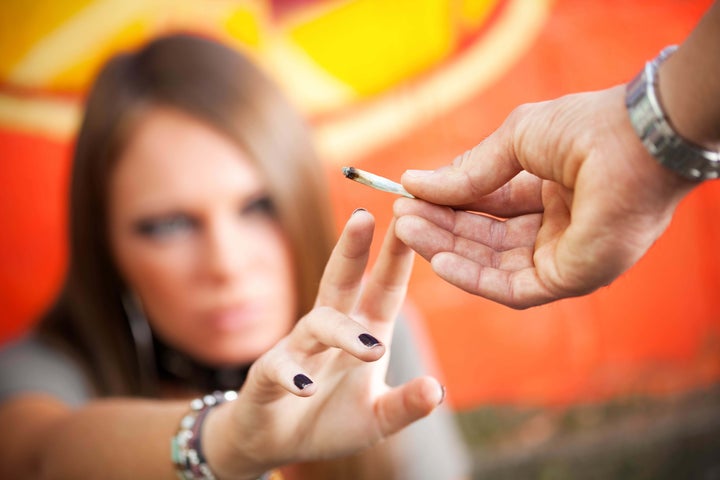
By Samantha Parent Walravens
Parents, if you think your teen isn’t using, or at least experimenting with drugs, you need to wake up. According to the National Center on Addiction and Substance Abuse (CASA), 75% of high school students have used addictive substances, and approximately 16% of the U.S. population ages 12 and over met clinical diagnostic criteria for addiction to nicotine, alcohol and other drugs. Drugs are easy to come by, with 44% of high school students saying they know a classmate who sells drugs.
We talked to Joronda Montano, program director and drug prevention specialist at NotMYKid, a non-profit that educates parents and middle and high school students on drug and alcohol abuse, eating disorders, depression/self injury and other issues. Here, Joronda shares what parents need to know about teen drug use today, and the best way to talk to your kids about drugs.
What inspired you to become a drug prevention specialist?
Joronda Montano: I grew up in LA at a time where substance abuse had hit its high -- in the 80s and 90s. When I started, I really wanted to help communities that were like mine and help them understand that every single child is at risk. Right now, we’re doing a Back to School campaign to help parents get started in the new school year, especially during those transition times when kids are moving from elementary to junior high and from junior high to high school.
What drugs are teens using – and abusing- today?
JM: According to the National Institute on Drug Abuse’s (NIDA) Monitoring the Future (MTF) survey , in 2016 alcohol remains the most common substance abused among teens, just as it is among adults. Marijuana comes next and then prescription drugs. Xanax (an anti-anxiety medication) is the most popular prescription drug, but you’ve also got Oxycontin and Vicodin. There are about 1600 kids who are trying prescription drugs for the first time every day.Teens are also experimenting with synthetic drugs like bath salts (not to be confused with Epsom salts) that are pretty new and haven’t been tracked in any survey yet.
What about vaping?
JM: Vaping is big. Usually when the kids get introduced to it, they're vaping just the “juice” (E-liquid comes in "kid-friendly" flavors like watermelon and blueberry). The perception of risk is low. There may not be any nicotine in it when they start, although there are issues with that. Any time that kids are getting that vapor into their lungs, they're going to have issues like popcorn lung that can cause irreversible lung disease. Then they're adding things to the vape, like THC and dab. Dab is butane hash oil. Basically, a small dab of THC is extracted from the cannabis leaf and is put into the vape cigarette.
What are the warning signs that your teen is using drugs?
JM: All the warning signs for drug and substance use sound just like signs of puberty. When you start to see a kid changing their friends, losing interest in things that they were interested in before, you maybe start to see grades change. The changes happen in three different areas. There's going to be a physical change, a social change, and a behavioral change. Read more warning signs here.
How should parents talk to their teens about drugs?
ONE: Start talking to your kids when they are young.
JM: Long before your kids face the pressures of adolescence, they should know your stance on drugs. If you convey the message that experimentation is OK, they’re more likely to use drugs. Have conversations with your kids at times that make sense—when you pick them up from school, when you’re having dinner at night. With younger kids—ages 8, 9 and 10-- start asking them simple questions each day like, “What is something that you liked about today, and something you didn’t?” You're taking inventory when you get those answers. It makes it more comfortable to continue to have a regular conversation as they get older.
Every year that substance use is delayed during the period of adolescent brain development, the risk of addiction and substance abuse decreases. - National Center on Addiction and Substance Abuse (CASA)
TWO: Set firm rules and expectations about drugs.
JM: As parents, you need to set expectations and “family rules” around drugs and alcohol use. Be clear and say, drugs are not something we do in our family. Parents' disapproval is a huge factor in preventing substance use. If a teen believes that their parent disapproves of drug and alcohol use, they are going to be less likely to use. On the other hand, if the teen thinks their parent is okay with it, they’re going to be more likely to use.
THREE: Understand the teenage brain.
JM: Teens are wired to take risks and experiment. Their brain at that age makes them impulsive and more likely to make risky decisions. A recent study on drug use in Iceland, which 20 years ago had the highest rate of teen alcohol use in all of Europe, found that replacing drug-induced highs with natural highs could drastically reduce substance abuse. The study’s lead researcher, Harvey Milkman, set in place a program in Iceland, called Project Self-Discovery, which offered teenagers natural-high alternatives to drugs. The number of teens using drugs and alcohol has since plummeted.
For kids who are seeking thrills, giving them a risk-taking but safe alternative, like skateboarding or BMX racing, could replace the synthetic high offered by drugs with a “natural” high. For kids who want the sedative effect of a depressant, getting them involved in yoga or running could produce a similar effect. The Iceland study showed that kids were not so much addicted to the substance as they were to the release of the hormone—the dopamine or serotonin.
FOUR: Give kids a “way out” of a risky situation.
JM: Give your teen a way to get out of a dangerous or risky situation. Decide on a code word that they can text you, and no questions asked, you will come and get them. Random drug testing gives them another way out when they are with friends who are using. They can tell them, “Hey, mom (or dad) is crazy. She drug tests me and so I can't do this with you now." It just makes it much easier. First Check is a 12-panel screen that you can do at home, it's super quick, less than five minutes, and is very accurate. We suggest randomly because if you do it regularly and the kid knows it's going to be on a particular day, then they could evade that test in a lot of different ways.
FIVE: Decide on consequences together.
JM: Talk to your teen about what they think the consequences should be if they are using drugs. Ask them, "What do you think the consequence should be?" That way, there is no surprise about what will happen if they are caught. "This is what we said we would do and you knew beforehand what was going to happen. You made this choice. You made this choice with the knowledge of what was going to happen, so you made an informed decision." That leads to a higher level of conversation. You can ask, “What's going on here? Let's really talk about this."
SIX: Keep communication lines open.
JM: Make sure your child knows that if they make the wrong choice, you’re still there for them. Kids should know that "I can talk to Mom or Dad at any time," they have the skills to do that, and you, as parents, give them the opportunity for that. If you put all three of those things together, you are more likely to get what you want. You have to keep working at it. Maintaining an open and non-judgmental line of communication is key to ensuring they keep you in the loop if something is going wrong.
Samantha is the editor of the New York Times-acclaimed anthology, TORN: True Stories of Kids, Career & the Conflict of Modern Motherhood, and co-author of GEEK GIRL RISING: Unleashing the Power of Women in Tech (St. Martin’s Press 2017).
